

What is employee engagement? - Engage For Success. Employee engagement is a workplace approach designed to ensure that employees are committed to their organisation’s goals and values, motivated to contribute to organisational success, and are able at the same time to enhance their own sense of well-being.
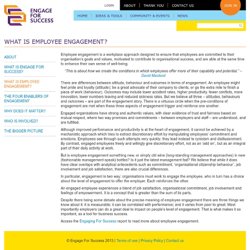
“This is about how we create the conditions in which employees offer more of their capability and potential.” – David Macleod There are differences between attitude, behaviour and outcomes in terms of engagement. An employee might feel pride and loyalty (attitude); be a great advocate of their company to clients, or go the extra mile to finish a piece of work (behaviour). Outcomes may include lower accident rates, higher productivity, fewer conflicts, more innovation, lower numbers leaving and reduced sickness rates. But we believe all three – attitudes, behaviours and outcomes – are part of the engagement story. CIOs: A Unified Strategy For Mobile Engagement Is The Best Way To Succeed. It’s hard to miss the buzz around mobile.
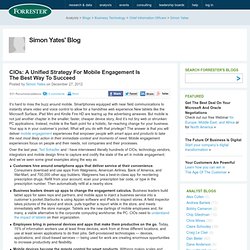
Smartphones equipped with near field communications to instantly share video and voice control to allow for a handsfree web experience.New tablets like the Microsoft Surface, iPad Mini and Kindle Fire HD are tearing up the advertising airwaves. But mobile is not just another chapter in the smaller, faster, cheaper device story.
And it’s not tiny web or shrunken PC applications. Instead, mobile is the flash point for a holistic, far-reaching change for your business. Your app is in your customer’s pocket. Employee engagement.pdf (application/pdf Object) Employeeengagement.pdf (application/pdf Object) Antecedents and consequences of employee engagement.
How leaders kill meaning at work - McKinsey Quarterly - Organization - Strategic Organization. As a senior executive, you may think you know what Job Number 1 is: developing a killer strategy.
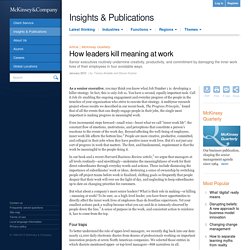
In fact, this is only Job 1a. You have a second, equally important task. Call it Job 1b: enabling the ongoing engagement and everyday progress of the people in the trenches of your organization who strive to execute that strategy. A multiyear research project whose results we described in our recent book, The Progress Principle, found that of all the events that can deeply engage people in their jobs, the single most important is making progress in meaningful work. Disengaged employees could help the competition - Skills-Universe. Good practices around recognition and reward, culture management and talent management can make a big difference to the innovativeness of employees.
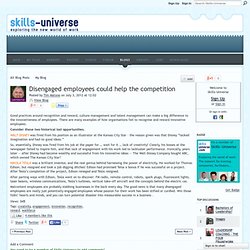
There are many examples of how organisations fail to recognise and reward innovative employees. Consider these two historical lost opportunities. WALT DISNEY was fired from his position as an illustrator at the Kansas City Star – the reason given was that Disney “lacked imagination and had no good ideas.” So, essentially, Disney was fired from his job at the paper for … wait for it … lack of creativity! Nourishing Employee Engagement. Mary Grassinger was in the midst of a career-defining struggle.

She was less than a year into her job as clinical nutrition manager for St. Turning Around Your Turnover Problem. Anna recently quit her job.
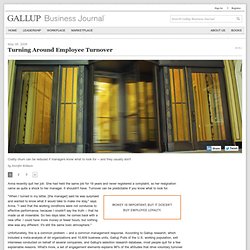
She had held the same job for 19 years and never registered a complaint, so her resignation came as quite a shock to her manager. It shouldn't have. Turnover can be predictable if you know what to look for. "When I turned in my letter, [the manager] said he was surprised and wanted to know what it would take to make me stay," says Anna. "I said that the working conditions were not conducive to effective performance, because I couldn't say the truth -- that he made us all miserable. Unfortunately, this is a common problem -- and a common management response.
Money can't buy love -- or loyalty According to James K. Money is important, but it doesn't buy employee loyalty. Pay can seem adequate to engaged employees and an insult to actively disengaged workers, even when the pay rate is essentially the same. Notice a pattern?
Leading Engagement From the Top. "You'd be amazed at how much I don't know about my business," says Tim, who owns a large construction company in the Midwest.
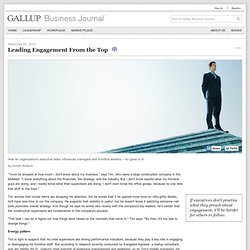
"I know everything about the financials, the strategy, and the industry. Facilitation. High levels of employee disengagement and under engagement. An employee of GE once said to Jack Welch: You have paid for my hands for 24 years, but you could have had my brain for free So even the most successful companies fails to engage all employees.

According to a recent survey on employee engagement in the US workforce from Modern Survey, it seems that only 10% of US employees feel they are fully engaged in the company they work for. 24% are “moderately engaged”, 30% feel they are “disengaged” and a staggering 37% are “under engaged”. Modern Survey isn’t the first firm to report low engagement numbers – Gallup,Blessing White along with others have all found low engagement rates within organizations. With such high levels of disengagement and under engagement, it’s clear that an enormous amount of performance potential is left untapped or underutilized by many organizations operating in the U.S.